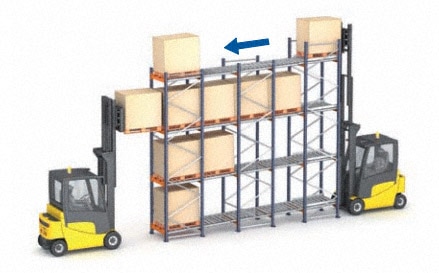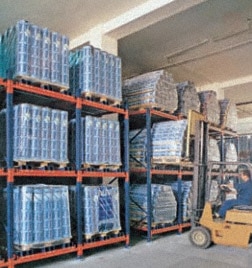FEFO / FIFO is a technique for managing loads that aims to supply products (to make them flow through the supply chain) by selecting those closest to expiration first (First Expired, First Out), and when the expiration is the same, the oldest first (First In, First Out).

Expiration can become the foundation on which a warehouse’s entire operation depends. If the operational basis depends on when an item was manufactured, its sell-by date and its time of arrival at the logistics center, then the rules of the game are much stricter because the cost of an erroneous shipment to a client can be very high.
Not only are sales reduced with a returned item or unsatisfied demand, but expired foodstuffs on a supermarket display rack can erode a brand’s image, not to mention the potential consequences for the health of the consumers.
The main concept behind FEFO / FIFO is the batch. This is perhaps one of the most popular logistics terms has become a household name even among consumers.
The “E” in FEFO gives us a date linked to a product’s life cycle that tells us when it will no longer be usable.
The “I” in FIFO refers to the date on which a product’s logistical distribution cycle began with its receipt and stocking. According to this logic, the more time an item remains in the warehouse the greater the probability of its deterioration or obsolescence.
The importance of FEFO / FIFO lies in the fact that it encompasses several of the cornerstones of a company’s priority management:
- It is a requirement demanded by the market.
- It is a quality target.
- In some industries it is legally regulated.
The cost of making FEFO / FIFO mistakes can emerge in some of the following ways:
- Cost of stock expiring on the shelf.
- Cost of premature obsolescence.
- Cost of a product with visible signs of deterioration.
- Cost of items returned by clients.
- Cost of time lost looking for a product in the warehouse.
- Opportunity cost of the unsatisfied demand.
- Cost of the damage to the brand’s image, potentially even leading to legal claims when the product’s properties are altered, thus affecting the consumer.
To understand this better, we need only put ourselves in the shoes of a consumer and think about how we should react:
- When we are in the refrigerator aisle, as a consumer, choosing a pack of yogurts, we apply precisely the opposite technique. That is, we glance at the label and pick the one with the latest expiration date, this way they will last longer. We check to make sure the product doesn’t have any defect (which is related to FIFO).
- When we are at home, in the role of distributor, we complain if a family member fails to observe FEFO / FIFO and doesn’t choose the yogurt with the earliest expiry date, urging them to consume the one they’re “supposed to” consume.

Why do we behave this way? It is simply an intelligent form of behavior that aims to minimize costs arising from expired products in our family finances and maximizing an idea of quality based on days of shelf life and properties such as ‘most recent’, ‘newest’, ‘freshest’, and so on. The consumer’s behavior is reproduced between sellers and buyers in a supply chain.
Our example embodies a basic rule and paradox of the market: if a buyer has the choice, and the price is the same, the buyer always chooses what is seen as the best product. But if the seller fails to properly synchronize the placement of items in the market, perhaps even prematurely placing the new batch so that different batches of the same item are displayed together, then the seller will probably not achieve greater profits. All this will stop older items from being sold and engender certain mistrust in the consumer. To make the paradox even more complicated, some companies, from time to time, have even come to justify that being out-of-stock is preferable.
Common requisites of FEFO / FIFO
If we train ourselves in logistics and reflect on the common requirements of the FEFO / FIFO system we wish to implement in our warehouse, we might decide on four areas to act on:
- Identification: product and layout elements.
- Information systems: ERP (Enterprise Resource Planning) / WMS (Warehouse Management Software).
- Resources: warehouse systems, layout, transport and personnel.
- Organization: procedures, task synchronization and work stations.
The solution is not merely setting priorities (ABC), obtaining financial approval for the project and implementing it, but also making a list of necessities and improvements for each area.
Logistical insight means realizing what the real needs are, the relation that exists between areas, and the capability of deploying resources to deal with a problem, for example, with a dose of organization and a dose of improved WMS functionality.
Identification to optimize FEFO/FIFO
Identification is relatively easy in terms of layout. Any element subject to a logistics task is labeled: aisles, areas docks, doors, locations etc.
Labeling and identifying products, or batches, is more involved. At which task within the logistics cycle to intervene in (reception, storage, picking, packaging, dispatch, etc.) must be determined and also the degree of information, depending on the sophistication of the ERP/WMS.
Aside from label design and printing, it must be ensured that labels are easily readable by the scanner under the operator’s ordinary working conditions.
Information System ERP/WMS
The vision of ERP / WMS information systems and what the batch control means is such that, as a minimum, its primary attributes will be considered to be:
- Expiry date.
- Batch creation date (when entered into the system).
- Antiquity (entrance into the warehouse).
These three dates intervene in the assigned stock algorithms and will come into play, for example, in starting an order preparation plan. Once sets of locations where you find each item are available, the demanded quantity is assigned in this hierarchical order by: expiry date, creation date, date of antiquity.
If the system does nothing, there would be the likelihood to dispatch expired batches. It´s not unusual to encounter this and the technical solution is that the “batch state” attribute intervenes, which will affect all presentations and quantities within the system on a universal level. Likewise, this will create an obvious blockage in the “n” stock days before its expiry date. The cost of “n” day varies in regards to the product, the delivery time and also the client or destination.
FEFO / FIFO concepts will present each case a series of new features that we would like to be covered in the ERP/WMS information system. Obviously, this will mean the re-designing of a few already existing functions. Here are a few examples:
New functions to be kept in mind:
Rules for mixing batches
- Batch genealogy (origin and destination log).
- Allocation of a specific batch, sole batch or standard batch.
- Handling of multi-reference/single-reference, multi-batch/single-batch pallets for each placement location.
- Batch status changes.
Redesigned features
- Cross-docking.
- Prioritizing pick-up by areas or storage systems.
- Prioritizing shortest allowed trips.
- Replenishment at set picking station.
- Transfers between warehouses (alteration of the warehouse antiquity entry date).
- Changes in documentation and labels.
Resources to keep in mind for FEFO/FIFO
Hereafter, some recommended warehouse solutions are shown for goods for which FEFO / FIFO management techniques are applied. This guideline is only informative in nature, since each system’s suitability will depend on a large number of additional criteria in its management procedures. As a rule, the impact of the available resources must be quantified and measured before any decision is made. The best solution will be the one which meets the needs of the business.
| Direct Access Systems | Material Handling Equipment |
|---|---|
| Selective pallet racking | Reach truck and counter-balanced forklift |
| Movirack mobile racking | Specific reach truck |
| Selective Racking: single and double-deep | Bilateral or trilateral stacker cranes |
| AS/RS Pallet Racking: narrow aisle | Stacker cranes |
| AS/RS Pallet Racking: single and double-deep | Pallet stacker, reach truck or counter-balanced forklift |
| High-density Systems | |
| Pallet flow racking using rollers | Counter-balanced forklift, reach truck, trilateral forklift, bilateral forklift or stacker crane |
| Semiautomatic Pallet Shuttle | Counter-balanced forklift, reach truck, trilateral forklift, bilateral forklift |
